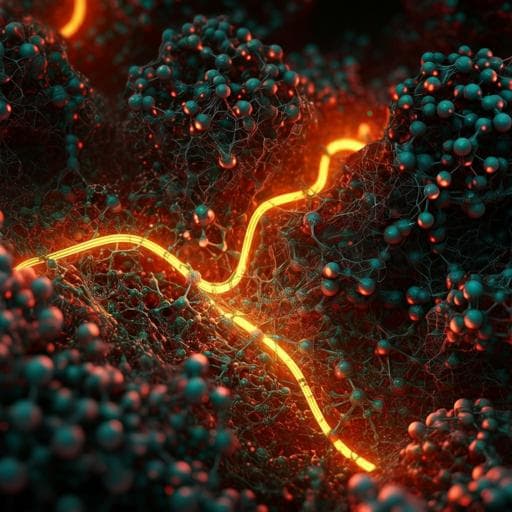
Chemistry
Phase regulation enabling dense polymer-based composite electrolytes for solid-state lithium metal batteries
Q. Wu, M. Fang, et al.
Discover how a phase regulation strategy employing MoSe₂ sheets enhances solid polymer electrolytes for lithium metal batteries, leading to remarkable performance in high-rate cycling and efficiency. This groundbreaking research was conducted by Qian Wu, Mandi Fang, Shizhe Jiao, Siyuan Li, Shichao Zhang, Zeyu Shen, Shulan Mao, Jiale Mao, Jiahui Zhang, Yuanzhong Tan, Kang Shen, Jiaxing Lv, Wei Hu, Yi He, and Yingying Lu.
~3 min • Beginner • English
Introduction
The study targets the development of safe, high-energy, long-life solid-state lithium metal batteries by improving PVDF-based solid polymer electrolytes. Conventional liquid electrolytes suffer from flammability, dendrite growth, and parasitic reactions. PVDF-based electrolytes are attractive due to mechanical strength, thermal stability, and interfacial compatibility, and residual polar solvent (e.g., DMF) combined with PVDF’s high dielectric constant promotes Li-salt dissociation and ion transport. However, PVDF-based electrolytes typically exhibit porous structures from polymer–solvent phase separation, leading to heterogeneous ion flux and dendrite growth, solvent-induced side reactions and narrow electrochemical stability windows, and ionic conductivities still below liquids. The key research question is whether phase regulation of PVDF via interactions with a 2D filler can densify the electrolyte, enhance dielectric properties and solvation structure toward SSIP, and simultaneously engineer the SEI to improve Li interfacial kinetics and stability for practical-rate, room-temperature operation with high-loading cathodes.
Literature Review
Prior strategies to improve PVDF-based electrolytes include electrolyte additives, varying Li salts/solvents, tuning solvent content, and anchoring solvents with fillers, which can suppress side reactions to some extent. Xu et al. reported a local high-concentration (LHC) structure (LiTFSI+DMSO embedded in PVDF spherulites) that mitigates interfacial reactions via solvent–polymer interactions, but solvent decomposition accelerates at high current (>0.5 mA cm−2), high rate (>1C), and high potential (>4.3 V), limiting cycle life. Attempts to increase ionic conductivity by adding fillers (e.g., hydroxides, LLTO) or modifying polymer structure to reduce PVDF crystallinity often yield modest gains due to PVDF’s rigidity, and fabricating dense PVDF-based electrolytes remains challenging. Thus, a new approach that densifies PVDF-based electrolytes while enhancing ion transport and interfacial stability is needed.
Methodology
Materials and electrolyte fabrication: MoSe2 nanosheets (MSs) were synthesized by in-situ selenization of blended (NH4)6Mo7O24·4H2O, Se, and Mg powders (0.3:1:1 wt ratio), heated to 800 °C for 4 h, followed by acid washing (dilute HCl), water rinsing, and drying at 110 °C. PVDF/LiFSI-based electrolytes were prepared by solution casting in DMF (PVDF:LiFSI = 3:2 by weight) with MSs added at 10, 15, and 20 wt% relative to PVDF (PVMS-10, PVMS-15, PVMS-20), dried at 55 °C for 24 h.
Structural and physicochemical characterization: XRD confirmed 2H-MoSe2 and electrolyte phases. SEM/FIB-SEM observed morphology and cross-sections; AFM-nano-IR mapped DMF C=O distribution; TGA and ss-NMR quantified residual DMF (~12–14 wt%). FTIR quantified PVDF β-phase content via Lambert–Beer law (β-phase peaks at 840 and 1388 cm−1; α-phase at 762 and 1360 cm−1). Broadband dielectric spectroscopy measured relative permittivity ε′ from −50 to 100 °C across 10¹–10⁷ Hz. Raman (FSI S–N–S bands) deconvoluted solvation structures into SSIP, CIP, AGG-1, AGG-2. Solid-state 7Li/19F NMR probed Li–DMF and Li–FSI interactions. Mechanical properties were measured (tensile strength, Young’s modulus).
Interfacial analysis: Cryo-STEM/TEM examined SEI thickness and phases after Li plating on Cu (0.1 mA cm−2, 6 h). TOF-SIMS and XPS (with sputter-depth profiling) analyzed SEI/CEI composition and distribution. AFM measured SEI surface roughness and modulus.
Electrochemistry: Ionic conductivity by EIS (1 MHz–0.1 Hz), activation energy via Arrhenius plots; electronic conductivity by chronoamperometry between stainless-steel electrodes; electrochemical stability window by LSV (0–6 V vs Li/Li+). Symmetric Li||Li cells evaluated exchange current density (ECD), critical current density (CCD) by time- and capacity-control protocols, critical deposition capacity (CDC), and long-term cycling at various current densities. Li||Cu cells measured Coulombic efficiency and Li deposition morphologies. Li||NCM811 coin cells (2 mg cm−2 NCM811, 450 µm Li) underwent CV, rate tests (0.1–5C), long-term cycling at 2C and 3C, elevated temperature (45 °C), higher cutoff voltage (4.5 V), high loadings (1.44 and 2.6 mAh cm−2), and low temperature (−20 °C). Single-layer pouch cells were assembled at two loadings/geometries and cycled.
Computations: DFT calculations modeled PVDF chain adsorption on MoSe2, revealing α→β transformation and asymmetric interactions (Mo with –CF2, Se with –CH2). CI-NEB computed Li diffusion barriers on SEI components’ stable surfaces: Li2Se(111), Li2O(111), Li2CO3(002), LiOH(001); adsorption energies and preferred sites determined; surface energies validated facet selection. Computational parameters included PAW-PBE potentials, dispersion corrections (D3), appropriate k-point meshes and cutoffs.
Key Findings
- Dense electrolyte formation and β-phase enhancement: Incorporating 15 wt% MoSe2 (PVMS-15) yields a dense composite (vs porous PVDF), higher tensile strength (from 0.6 to 1.28 MPa) and Young’s modulus (from 213 to 1539 MPa), with thickness ~80 µm (vs 100 µm). FTIR shows β-phase content increases from 39% (PVDF) to 64% (PVMS-15) and up to 77% at 20 wt% (aggregation observed at 20 wt%).
- Dielectric and solvation regulation: Relative permittivity at 25 °C increases from 9.6 (PVDF) to 21.1 (PVMS-15), correlating with β-phase ratio. Raman deconvolution shows SSIP increases (PVDF: SSIP 15.21%, CIP 40.53%, AGG-1 32.69%, AGG-2 11.57%; PVMS-15: AGG-1 17.74%, AGG-2 10.28%, SSIP markedly increased), supported by 7Li/19F ss-NMR downfield shifts indicating weakened FSI–Li and strengthened Li–DMF coordination. AFM-nano-IR reveals uniform DMF distribution in PVMS-15 (vs aggregation at PVDF spherulites).
- Ionic transport and stability: Ionic conductivity at 25 °C increases from 2.1×10−5 S cm−1 (PVDF) to 6.4×10−4 S cm−1 (PVMS-15). Activation energy for ion transport decreases from 0.26 eV to 0.07 eV. LSV indicates anodic stability extended to 4.7 V vs Li/Li+. Electronic conductivity remains low (semiconducting MS has negligible effect).
- SEI engineering with Li2Se: Cryo-TEM shows a thinner, smoother SEI (~13 nm) for PVMS-15 with mosaic structure containing Li2O, Li2CO3, LiOH, and clear Li2Se (111)/(200) nanocrystals; PVDF SEI is rougher/thicker with more LiOH/Li2O/Li2CO3 (indicative of DMF decomposition). CV of Li||Cu indicates formation of Li2Se at potentials higher than DMF reduction, suppressing side reactions and improving kinetics. DFT/NEB yields Li diffusion barriers: Li2Se(111) 0.056 eV (fast), vs LiOH(001) 0.25 eV, Li2O(111) 0.30 eV, Li2CO3(002) 0.22 eV.
- Symmetric-cell performance: Li|PVMS-15|Li achieves CCDs of 2.3 mA cm−2 (time control) and 8.3 mA cm−2 (capacity control), vs 0.8 and 1.6 mA cm−2 for PVDF. Exchange current density increases to 0.245 mA cm−2. Long-term cycling: 1900 h at 0.1 mA cm−2 without shorting (PVDF shorted at 290 h); stable cycling 480 h at 1 mA cm−2; CDC up to 2.6 mAh cm−2.
- Li||Cu efficiency and morphology: Average CE 97.8% over 55 cycles with PVMS-15 (PVDF: 86.4% and short circuit after 12 cycles). Li deposition forms dense, connected particles with PVMS-15; PVDF yields small, uneven deposits.
- Full-cell performance (Li||NCM811, coin cells): Discharge capacities: 193.4 (0.1C), 169.2 (1C), 144 (2C), 112.9 mAh g−1 (5C), outperforming PVMS-10, PVMS-20, and PVDF. Rct increases modestly (35→50 Ω) after rate test for PVMS-15 vs large increase for PVDF (60→180 Ω). Long cycling: 2000 cycles at 2C with average CE 99.7% (PVDF shorted at 341 cycles, CE 97.5%); at 3C, 2000 cycles with 60.3% capacity retention. Elevated T (45 °C): 85.7% retention after 660 cycles (PVDF rapid fade, CE 81.3%). High cutoff 4.5 V: 600 cycles with 77.8% retention (PVDF overcharge in initial cycle). High loadings: 1.44 mAh cm−2 for 100 cycles; 2.6 mAh cm−2 for 25 cycles. Low T: cycling at −20 °C for 150 cycles.
- Pouch cells: Cell-1 (2 mg cm−2, 4×4.5 cm, 20 µm Li each side) delivers 170 mAh g−1 with 78.5% retention after 110 cycles and survives folding/puncture/cutting tests; Cell-2 (8 mg cm−2) cycles 20 times at 0.1C.
- Interfacial/mechanical improvements: SEI with PVMS-15 shows higher Young’s modulus (4.73 GPa) and lower roughness (10.5 nm) vs PVDF (1.54 GPa, 16.3 nm). On the cathode, CEI is thinner (~4 nm vs ~7.5 nm) with mitigated rock-salt phase formation and higher I(003)/I(104) ratio, indicating reduced structural degradation. Overall, PVMS-15 cells outperform most reported PVDF- and other polymer-based SSBs under similar conditions.
Discussion
Phase regulation via MoSe2–PVDF asymmetric interactions converts PVDF to β-phase and densifies the electrolyte, elevating dielectric constant and uniformly distributing residual DMF. The higher ε promotes Li salt dissociation and shifts solvation toward SSIPs, reducing ion association and activation energy, thereby boosting ionic conductivity at room temperature. At the Li interface, the in-situ formation of Li2Se in the SEI creates a fast-ion-conducting pathway with extremely low surface diffusion barriers, while its higher formation potential than DMF reduction suppresses solvent decomposition. Consequently, Li deposition becomes more uniform with higher exchange current, increased CCD/CDC, thinner and mechanically stronger SEI, and improved Coulombic efficiency. On the cathode side, the denser electrolyte and stabilized interphase mitigate electrolyte oxidation, yielding a thinner CEI and reduced surface phase transitions of NCM811. These synergistic effects enable high-rate (up to 3C), long-life (up to 2000 cycles), high-loading, and wide-temperature operations, validating the strategy’s relevance for practical solid-state lithium metal batteries.
Conclusion
The work demonstrates a PVDF-based composite electrolyte (PVMS-15) that achieves a dense microstructure, elevated dielectric constant, altered solvation toward SSIP, high ionic conductivity (6.4×10−4 S cm−1), and low activation energy (0.07 eV). Through in-situ reactions between MoSe2 and Li, a Li2Se-containing SEI forms, enhancing interfacial kinetics and suppressing solvent decomposition, which delivers robust symmetric-cell cycling and outstanding Li||NCM811 full-cell performance under high rates, high loadings, elevated cutoff voltage, and low temperature, including pouch-cell demonstrations. The strategy addresses key limitations of PVDF-based electrolytes and offers a scalable, low-cost route to stable, room-temperature solid-state lithium metal batteries. Future work may optimize filler content and distribution, further raise cathode loadings and cycle life, and explore compatibility with other high-voltage cathodes and solvent systems.
Limitations
- Filler loading window: At 20 wt% MoSe2 (PVMS-20), filler aggregation led to uneven morphology and poor interfacial contact, indicating a limited compositional window (optimal at 15 wt%).
- High-loading longevity: While high-loading operation (2.6 mAh cm−2) is demonstrated, cycle life at this loading is limited to 25 cycles in coin cells.
- Residual solvent: The electrolytes retain ~12–14 wt% DMF; although decomposition is mitigated by densification and Li2Se formation, residual solvent presence may still constrain long-term stability under extreme conditions.
- Pouch-cell durability: Pouch cell-2 (8 mg cm−2) was validated for 20 cycles at 0.1C; extended cycling and higher-rate performance for thick electrodes remain to be established.
Related Publications
Explore these studies to deepen your understanding of the subject.







